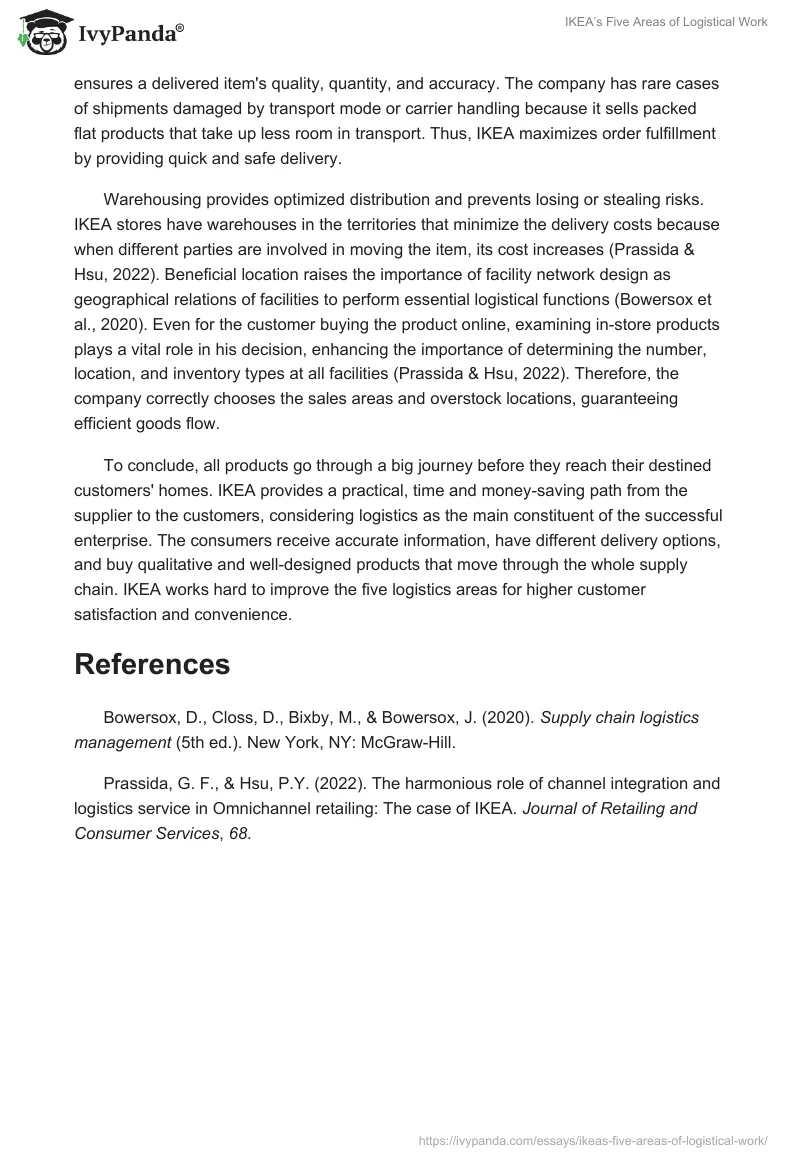Many companies worldwide focus on logistics to improve customer satisfaction, production rates, and inventory control. Many customers do not realize the efforts behind the products on the store shelves that require complicated distribution strategies. Companies should effectively transport goods to decrease waste of materials, time, and expenses. Companies like IKEA in different countries implement profitable supply chain operations and inventory management to maintain their value proposition.
The company’s value proposition determines its five areas of logistics. The leading furnishing firm, IKEA, aims to provide well-designed, comfortable, affordable furnishings at lower prices to attract as many customers as possible. Therefore, its concern with affordability provides a competitive advantage. The first stage, order processing, is responsible for accurate information, people’s awareness, and responsive supply chain demand, which gives a chance to interpret customer behavior on time (Bowersox et al., 2020). The study by Prassida and Hsu (2022) proves that IKEA has well-established order processing as the customers are always informed about their rights and opportunities. For example, they know how to access multiple channels such as websites, stores, and mobile applications with all available features and services, demonstrating IKEA’s channel transparency. Thus, ensuring a precise and rapid order fulfillment process is the key to starting the whole logistics.
The inventory stage achieves customer satisfaction with the minimum inventory commitment. IKEA’s customers note that its inventory always increases to meet orders when possible demand increases, proving that the company focuses on its product profitability. Moreover, “products are consistently available in inventory when ordered” because retailers track product availability precisely and customer choices (Prassida & Hsu, 2022, p.7). By understanding consumer trends, IKEA provides better services to its customers.
All companies have managers responsible for the transportation of goods. For IKEA, with more than 350 stores worldwide, having efficient transportation management is essential as the store targets transport efficiency with minimum delivery costs (Prassida & Hsu, 2022). Customers can either pick up the product themselves or wait for a delivery, utilizing different transport types: road, rail, and sea. Moreover, IKEA ensures a delivered item’s quality, quantity, and accuracy. The company has rare cases of shipments damaged by transport mode or carrier handling because it sells packed flat products that take up less room in transport. Thus, IKEA maximizes order fulfillment by providing quick and safe delivery.
Warehousing provides optimized distribution and prevents losing or stealing risks. IKEA stores have warehouses in the territories that minimize the delivery costs because when different parties are involved in moving the item, its cost increases (Prassida & Hsu, 2022). Beneficial location raises the importance of facility network design as geographical relations of facilities to perform essential logistical functions (Bowersox et al., 2020). Even for the customer buying the product online, examining in-store products plays a vital role in his decision, enhancing the importance of determining the number, location, and inventory types at all facilities (Prassida & Hsu, 2022). Therefore, the company correctly chooses the sales areas and overstock locations, guaranteeing efficient goods flow.
To conclude, all products go through a big journey before they reach their destined customers’ homes. IKEA provides a practical, time and money-saving path from the supplier to the customers, considering logistics as the main constituent of the successful enterprise. The consumers receive accurate information, have different delivery options, and buy qualitative and well-designed products that move through the whole supply chain. IKEA works hard to improve the five logistics areas for higher customer satisfaction and convenience.
References
Bowersox, D., Closs, D., Bixby, M., & Bowersox, J. (2020). Supply chain logistics management (5th ed.). New York, NY: McGraw-Hill.
Prassida, G. F., & Hsu, P.Y. (2022). The harmonious role of channel integration and logistics service in Omnichannel retailing: The case of IKEA. Journal of Retailing and Consumer Services, 68.


